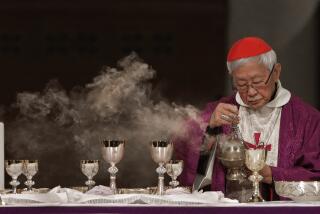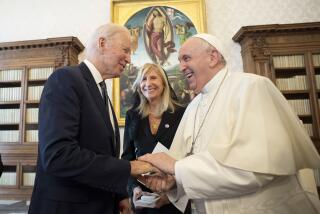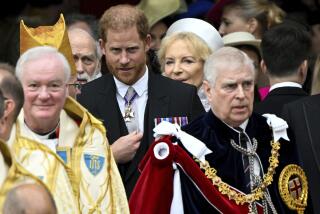John Paul II Announces 31 New Cardinals
VATICAN CITY â Pope John Paul II appointed 31 new cardinals Sunday, enlarging the body that will produce his successor and further solidifying his conservative influence on the Roman Catholic Church and its powerful hierarchy.
The new âprinces of the church,â as the cardinals are known, included only one U.S. prelate -- Los Angeles-born Justin Rigali, archbishop of Philadelphia -- and one each from Mexico, Guatemala and Brazil. Six are Italians and one was appointed in pectore, or close to the heart, meaning his name will not be revealed because of religious persecution in his home nation.
John Paul, 83 and in poor health, will elevate the new cardinals, bestowing upon them their trademark scarlet birettas, on Oct. 21 in a ceremony known as a consistory. It will wrap up a week of celebrations marking the pontiffâs 25 years in office, one of the longest reigns in modern history.
The men named Sunday will become part of the College of Cardinals. Members under the age of 80 are eligible to take part in the election -- almost always from within their own ranks -- of a new pope upon the death of a sitting pontiff.
Even before Sunday, John Paul had named all but five of those who can take part in electing a new pope, which will now reach the total of 135. Like him, they are for the most part theological and political conservatives. He therefore has assured his legacy by placing a personal stamp on both the electors who will choose the pope and the candidates for the position.
The pope, and most of the cardinals, have promoted a traditional Catholicism, steadfastly opposing the ordination of women priests, gay marriage and the use of contraception -- to the chagrin of many American Catholics.
âWho becomes a cardinal greatly affects who becomes pope, since the cardinals usually elect him from their number,â Father Thomas J. Reese said in his comprehensive book âInside the Vatican.â âNot surprisingly, popes tend to appoint people who are their friends or whose views reflect their own.â
With Rome afflicted Sunday by both a steady rainstorm and a massive electrical blackout, John Paul had to read the names from an office window overlooking a drenched St. Peterâs Square, where tourists and pilgrims had gathered to hear the customary blessing.
Power was out across Italy because of a technical failure, and Vatican City was no exception. To broadcast the popeâs remarks, Vatican officials had to scramble to install a generator lent by the RAI state television network.
At the darkened Vatican press office, journalists listened to the news on transistor radios and then wrote out reports with paper and pen. When Vatican officials distributed the list of appointments, journalists -- fearful the electricity had shut down copying machines and there wouldnât be enough -- practically knocked one another down to get a copy.
There are no fixed rules for when a consistory is held, and this will be this popeâs ninth. Following the recent pattern, most Vatican-watchers were not expecting a new group of cardinals to be named until early next year, three years after the last group was installed.
With the appearance that the timing of the appointments was accelerated, the pope inevitably fueled already intense speculation over his health.
Few would dispute that he has suffered a steep deterioration in recent months. Suffering from Parkinsonâs disease and a variety of hip and knee ailments, John Paul took the rare step Wednesday of canceling his weekly general audience.
During his last trip abroad -- to Slovakia on Sept. 11-14 -- he was unusually weak, unable to finish reading any of his sermons or speeches. His condition raised fears that the most-traveled pope would, at the least, have to stick closer to home. Seeking to allay the concerns, however, chief Vatican spokesman Joaquin Navarro-Valls said that John Paul is considering new invitations to travel.
The new papabili, Italian for âpope-ables,â included several men who already hold top positions in the Curia, the churchâs administrative body, among them the Vaticanâs foreign minister, Jean-Louis Tauran of France, and John Paulâs personal theologian, the Swiss-born Georges Marie Cottier, as well as prelates in charge of important dioceses representing some of the worldâs 1 billion Catholics.
Throughout his papacy, John Paul has expanded both the size and geographical diversity of the College of Cardinals. He has routinely pushed the number beyond the limit of 120 members, and he has broadened the range of countries, especially adding those where the church is beleaguered by unfriendly regimes.
Of Sundayâs group, eight are from Europe, including former communist lands such as Croatia, Hungary, the Czech Republic and Poland. One each hails from Sudan, Nigeria, Ghana, Japan and Vietnam.
Despite widespread speculation to the contrary, the new archbishop of Boston, Sean OâMalley, was not included. OâMalley replaced Cardinal Bernard Law this year after Law resigned over the sex-abuse scandal that has plagued the church in the U.S. and elsewhere.
The lone American, Rigali, 68, was educated at Catholic schools and seminaries in Southern California, rose through the church hierarchy and until recently headed the archdiocese of St. Louis.
He has had a career of ups and downs, having held a number of important posts and then less prestigious ones.
The bishop who now becomes Guatemalaâs first cardinal is something of a departure, at least in terms of his politics. The well-respected Rodolfo Quezada Toruno, 71, served in the early 1990s as a mediator in talks between Guatemalaâs hard-line government and its rebellious indigenous people. With a notorious human rights record, the Guatemalan government eventually sacked Quezada as negotiator, accusing him of bias in favor of the rebels.
The new cardinals âcome from various parts of the world and worked in various ways in the service of the people of God,â the pope said Sunday. âThey reflect the universality of the church with the diversity of their ministries.â
More to Read
Sign up for Essential California
The most important California stories and recommendations in your inbox every morning.
You may occasionally receive promotional content from the Los Angeles Times.











